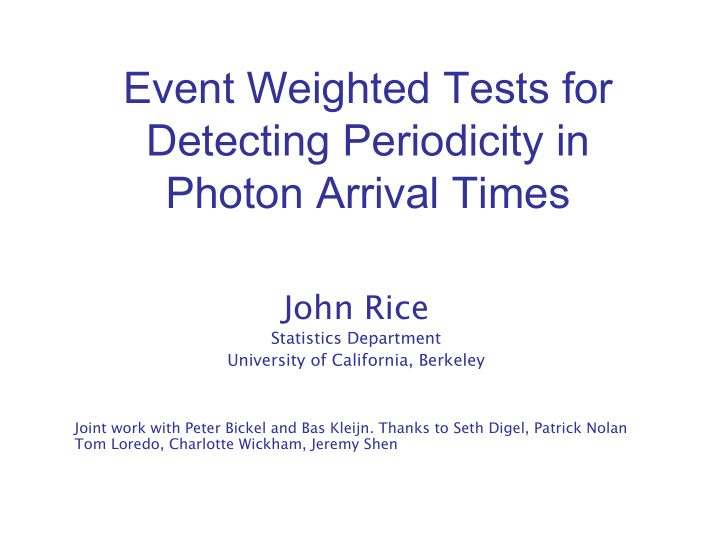



Event Weighted Tests for Detecting Periodicity in Photon Arrival Times John Rice Statistics Department University of California, Berkeley Joint work with Peter Bickel and Bas Kleijn. Thanks to Seth Digel, Patrick Nolan Tom Loredo, Charlotte Wickham, Jeremy Shen
Outline • Motivation: EGRET sources and gamma-ray pulsars • Detection as an hypothesis testing problem • A score test and discussion of its properties • Difficulties of a blind search • Integration over frequency bands as an alternative to discretization • Use of simulation and extreme value theory to assess significance
EGRET Sources
Gamma-Ray Pulsars radio quiet Many gamma-ray sources are unidentified and may be pulsars, but establishing that these sources are periodic is difficult. Might only collect ~1500 photons during a 10 day period.
Detection problem Barycentric corrected arrival times 0 < t 1 < … < t N < T. For EGRET, N ~ 1000, T ~ 10 days Energy and incidence angle of each photon. How should this information be used? Some photons come from source and some from background. Question : Is the source periodic, perhaps with decaying frequency? Pulse profile unknown.
Detection problem as hypothesis test Unpleasant fact: There is no optimal test. Even if the frequency were known, a detection algorithm optimal for one pulse profile will not be optimal for another one. No matter how clever you are, no matter how rich the dictionary from which you adaptively compose a detection statistic, no matter how multilayered your hierarchical prior, your procedure will not be globally optimal. The pulse profile ν (t) is an infinite dimensional object. Any test can achieve high power against local alternatives for at most a finite number of directions. In other words, associated with any particular test is a finite dimensional collection of targets and it is only for such targets that it is highly sensitive. Consequence: You have to be a [closet] Bayesian and choose directions a priori . Lehman & Romano. Testing Statistical Hypotheses. Chapt 14
Specifying a target Consider testing against a template for the pulse profile, a probability density: Model the arrival times as a Poisson process with rate function: rate instrument sensitivity proportion from source
Likelihood function and score test
Posterior probability Score test that the photon was from the source Neglible for large T
Relationship to classical tests in the un-weighted case
Weight function Depends on spectra of source and background through their ratio
Weight function
Weight function
Detection sensitivity: power of the test Signal to Noise Ratio
Power
Power: effect of frequency misspecification High accuracy is required to gain power from higher harmonics
Example: template
Example: template
Example: weight function
Example: weight function
Example: weight function
Difficulties Frequency unknown Spin down Large search space Glitches Celestial foreground Barycentric time correction Pulse profile unknown Computational demands for a blind search are very substantial. A heroic search using a 512 processor supercomputer did not find any previously unknown gamma-ray pulsars in EGRET data. (Chandler et al, 2001).
Search Space From Chandler et al (2001)
Search Space Consider no drift. Good frequency resolution depends on matching phase of photons at beginning and end of the record. If true frequency is f 0 , the number of cycles in time T is T/f 0 , so if the hypothesized frequency is f = f 0 + δ f, δ f should be o(T -1 ) in order for a photon at the end of the record to be in phase with one at the beginning. The phase error at the end of the record is T δ f. 10 days = 864,000 sec,- δ f = T -1. If a 40 Hz range has to be searched, a minimum of 40 x 864000 = 34,560,000 possible frequencies must be examined. Similarly, drift must be resolved within o(T -2 ). To search the interval of possible frequency derivatives at this resolution, about 400-500 values must be examined. Consequence is that a test statistic must be evaluated ~10 9 values of frequency and its derivative.
Histograms and density estimates for phased and folded arrival times from Geminga t* = t mod P (P = 1/f) for increments in f of size 10 -7 (.12/T)
Example: Vela
Crab
Power vs Computational Cost
Blocking Vela and Crab Vela: 318 blocks Crab: 25 blocks
Integration versus discretization Rather than fine discretization of frequency, consider integrating the test statistic over a frequency band using a symmetric probability density g(f). Decreasing function of |t j - t
Requires a number of operations quadratic in the number of photons. However the quadratic form can be diagonalized in an eigenfunction expansion, resulting in a number of operations linear in the number of photons. (In the case that g () is uniform, the eigenfunctions are the prolate spheroidal wave functions.) Then Power is still lost in high frequencies unless the support of g is small. This procedure can be extended to integrate over tiles in the plane when
Assessing significance At a single frequency, significance can be assessed easily through simulation. In a broadband blind search this is not feasible and furthermore one may feel nervous in using the traditional chi-square approximations in the extreme tail (it can be shown that the limiting null distribution of the integrated test statistic is that of a weighted sum of chi-square random variables). We are thus investigating the use of classical extreme value theory in conjunction with affordable simulation.
Gumbel Approximation
Tail Approximations According to this approximation, in order for a Bonferonni corrected p-value to be less than 0.01, a test statistic of about 11 standard deviations or more would be required.
log[- log F(t)] versus t
Thank you
Example: Geminga Main frequency only, N=1 Main frequency plus equally weighted first harmonic
Recommend
More recommend